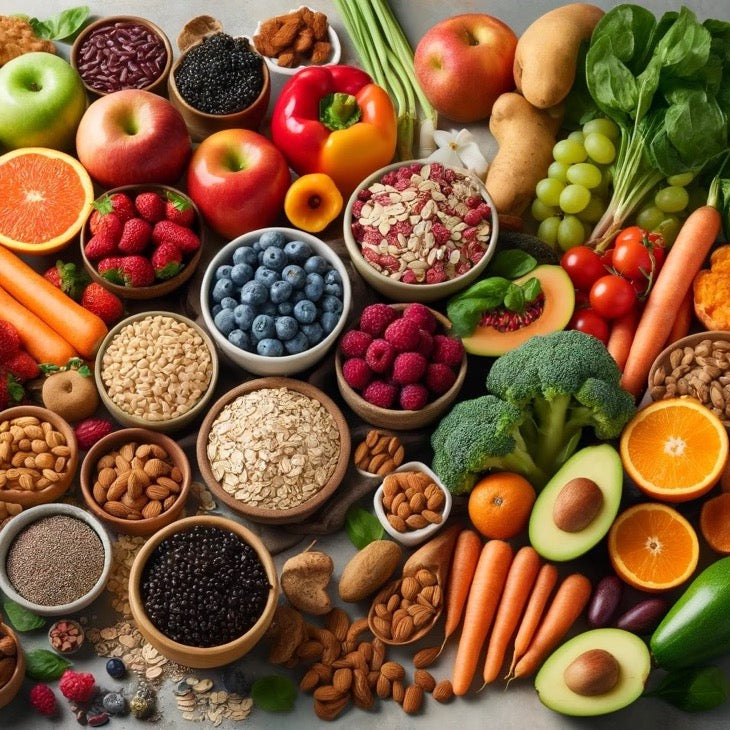
Boost Your Health: Discover the Benefits and Sources of Fiber-Rich Foods
Share
Fiber is an essential component of a healthy diet, yet many people fall short of the recommended daily intake. Despite its importance, fiber often takes a back seat to other nutrients like protein and fat. However, getting enough fiber can have profound effects on your overall health. In this comprehensive guide, we will delve into the benefits of fiber, identify fiber-rich foods, and provide tips on how to increase your fiber intake for better health and wellness. Are you getting enough fiber? Let's find out.

What is Fiber?
Dietary fiber, also known as roughage, is the part of plant foods that the body can't digest or absorb. Unlike fats, proteins, or carbohydrates, which your body breaks down and absorbs, fiber isn't digested by your body. Instead, it passes relatively intact through your stomach, small intestine, and colon and out of your body. Fiber is generally classified into two categories:
-
Soluble Fiber: This type of fiber dissolves in water to form a gel-like material. It can help lower blood cholesterol and glucose levels. Soluble fiber is found in oats, peas, beans, apples, citrus fruits, carrots, barley, and psyllium.
-
Insoluble Fiber: This type of fiber promotes the movement of material through your digestive system and increases stool bulk, so it can be of benefit to those who struggle with constipation or irregular stools. Whole-wheat flour, wheat bran, nuts, beans, and vegetables, such as cauliflower, green beans, and potatoes, are good sources of insoluble fiber.
Health Benefits of Fiber
Incorporating adequate fiber into your diet can offer numerous health benefits, including:
- Digestive Health - Fiber is perhaps best known for its ability to prevent or relieve constipation. Insoluble fiber adds bulk to the stool and promotes regular bowel movements. Soluble fiber absorbs water and can help soften stools. A diet high in fiber can also reduce the risk of developing hemorrhoids and small pouches in your colon (diverticular disease). With gut health being a major focus (70% of your immune system is in your gut) this should be a major focus.
- Heart Health - Soluble fiber can help lower blood cholesterol levels by reducing low-density lipoprotein, or "bad" cholesterol. Studies also have shown that high-fiber foods may have other heart-health benefits, such as reducing blood pressure and inflammation.
- Blood Sugar Control - For people with diabetes, fiber — particularly soluble fiber — can slow the absorption of sugar and help improve blood sugar levels. A healthy diet that includes insoluble fiber has been associated with a reduced risk of developing type 2 diabetes.
- Weight Management - High-fiber foods tend to be more filling than low-fiber foods, so you're likely to eat less and stay satisfied longer. And high-fiber foods tend to take longer to eat and to be less "energy dense," which means they have fewer calories for the same volume of food.
- Cancer Prevention - A high-fiber diet has been associated with a reduced risk of various cancers, including colorectal cancer. Fiber, particularly from whole grains, may help reduce the risk of dying from cardiovascular disease and all cancers.
Fiber-Rich Foods to Incorporate into Your Diet
To enjoy the benefits of fiber, it's essential to include a variety of fiber-rich foods in your diet. Here are some excellent sources of fiber:
- Fruits
- Apples (with skin): Apples are a great source of both soluble and insoluble fiber. An apple with the skin provides about 4.4 grams of fiber.
- Bananas: Bananas provide about 3.1 grams of fiber per medium-sized fruit.
- Berries: Raspberries and blackberries are particularly high in fiber, offering about 8 grams of fiber per cup.
- Vegetables
- Carrots: One cup of raw carrots provides about 3.6 grams of fiber.
- Broccoli: This cruciferous vegetable offers about 5.1 grams of fiber per cup when cooked.
- Sweet Potatoes: A medium-sized sweet potato with skin provides about 4 grams of fiber.
- Legumes
- Lentils: Lentils are a powerhouse of fiber, with about 15.6 grams per cup when cooked. Organic Pharmer's Lentil Soup is the perfect way to get some of these delicious legumes.
- Chickpeas: One cup of cooked chickpeas provides about 12.5 grams of fiber.
- Black Beans: Black beans offer about 15 grams of fiber per cup when cooked.
- Whole Grains
- Oats: A cup of cooked oatmeal provides about 4 grams of fiber.
- Quinoa: This versatile grain offers about 5.2 grams of fiber per cup when cooked.
- Brown Rice: One cup of cooked brown rice contains about 3.5 grams of fiber.
- Nuts and Seeds
- Chia Seeds: Just two tablespoons of chia seeds provide about 10 grams of fiber.
- Almonds: A one-ounce serving of almonds (about 23 nuts) contains about 3.5 grams of fiber.
- Flaxseeds: Two tablespoons of flaxseeds offer about 5.6 grams of fiber.
Tips for Increasing Fiber Intake
Here are some practical tips to help you increase your daily fiber intake:
- Start Your Day with Fiber - Begin your day with a high-fiber breakfast. Choose cereals that have at least 5 grams of fiber per serving. Opt for whole-grain cereals or add a few tablespoons of unprocessed wheat bran to your favorite cereal.
- Incorporate More Vegetables - Add vegetables to your meals, whether it's by including a salad with your lunch or dinner or by snacking on raw vegetables throughout the day. Aim to fill half your plate with vegetables at each meal.
- Choose Whole Grains - Whenever possible, choose whole grains over refined grains. This includes opting for whole-grain bread, pasta, and rice. Look for products that list whole grains as the first ingredient on the label.
- Snack on Fiber-Rich Foods - Keep high-fiber snacks on hand, such as fruits, vegetables, nuts, and seeds. These make for quick and healthy snacks that can help you reach your daily fiber goals.
- Add Legumes to Your Diet - Incorporate beans, lentils, and other legumes into your meals. They can be added to soups, stews, salads, and even casseroles. Legumes are an excellent source of fiber and protein.
- Hydrate Well - Drinking plenty of water is crucial when increasing fiber intake. Fiber works best when it absorbs water, making your stool soft and bulky.
Potential Challenges and Solutions
Increasing fiber intake can come with some challenges. Here are a few common issues and solutions:
- Gas and Bloating - A sudden increase in fiber can cause gas and bloating. To minimize this, gradually increase your fiber intake over a few weeks. This allows your digestive system to adjust.
- Taste and Texture Preferences - Some people may not like the taste or texture of high-fiber foods. Experiment with different foods and recipes to find those that you enjoy. Blending fruits and vegetables into smoothies can also make them more palatable.
- Busy Lifestyle - A busy lifestyle can make it challenging to prepare high-fiber meals. Planning and prepping meals in advance can help. Keep a stock of frozen vegetables and canned beans for quick and easy meals.
Delicious Fiber-Rich Recipes
To help you get started, here are a few delicious recipes that are packed with fiber:
Quinoa Salad with Chickpeas and Vegetables

Ingredients:
- 1 cup quinoa, cooked
- 1 can chickpeas, drained and rinsed
- 1 cup cherry tomatoes, halved
- 1 cucumber, diced
- 1 red bell pepper, diced
- 1/4 cup red onion, finely chopped
- 1/4 cup fresh parsley, chopped
- 2 tablespoons olive oil
- Juice of 1 lemon
- Salt and pepper to taste
Instructions:
- In a large bowl, combine the cooked quinoa, chickpeas, cherry tomatoes, cucumber, bell pepper, red onion, and parsley.
- Drizzle with olive oil and lemon juice, and season with salt and pepper.
- Toss to combine and serve chilled.
Overnight Chia Pudding

Ingredients:
- 1/4 cup chia seeds
- 1 cup almond milk (or any plant-based milk)
- 1 tablespoon maple syrup or honey
- 1/2 teaspoon vanilla extract
- Fresh fruit for topping (berries, banana slices, etc.)
Instructions:
- In a bowl, combine chia seeds, almond milk, maple syrup, and vanilla extract.
- Stir well and let it sit for 5-10 minutes, then stir again to prevent clumping.
- Cover and refrigerate overnight.
- In the morning, stir the pudding and top with fresh fruit before serving.
Black Bean and Sweet Potato Tacos

Ingredients:
- 2 large sweet potatoes, peeled and diced
- 1 tablespoon olive oil
- 1 teaspoon chili powder
- 1/2 teaspoon cumin
- Salt and pepper to taste
- 1 can black beans, drained and rinsed
- 8 small gluten free tortillas
- Toppings: avocado slices, salsa, chopped cilantro, lime wedges
Instructions:
- Preheat oven to 400°F (200°C). Toss the diced sweet potatoes with olive oil, chili powder, cumin, salt, and pepper.
- Spread the sweet potatoes on a baking sheet and roast for 25-30 minutes, or until tender.
- In a small saucepan, heat the black beans until warm.
- Assemble the tacos by placing sweet potatoes and black beans on each tortilla. Top with avocado, salsa, cilantro, and a squeeze of lime.
Wrapping it up
Fiber is a crucial part of a healthy diet, offering a wide range of benefits from improved digestive health to reduced risk of chronic diseases. By incorporating a variety of fiber-rich foods into your daily meals, you can take significant steps toward better health and wellness. Start today by adding more fruits, vegetables, whole grains, legumes, nuts, and seeds to your diet. With the tips and recipes provided, you'll be well on your way to meeting your fiber goals and enjoying the many health benefits that come with a fiber-rich diet.
